There’s a ruin of what some believe to be a pagan Roman church in the garden of a private residence, in a very small town just south of Rome, whose stone stairs leading to its alleged former altar are so completely worn through in the center that they resemble what a stick of butter looks like if you held a hot spoon to its center. I saw it in the Fall of 1998 while on vacation in Italy. I’d seen stairs like it before in England and had heard about the ones in Arles, France, but these were much older by at least 2000 years.
The owner told me that the stairway once led to a fresh water spring before Vesuvius, in 79 AD, covered the area in ash. Another theory was that the stairs led to a brothel. But no one knows for sure and most likely never will. Everything, even educated guesses on the mysterious stairs, are merely supposition.
 But whatever once laid beyond those stairs, whether beloved, a necessity or a fascination –the three main things humankind gravitates towards their entire lives- isn’t important, at least to me. It’s merely enough to know that something stimulated human desire, whether born of thirst or longing, to make me acknowledge that something important happened there, over and over again.
But whatever once laid beyond those stairs, whether beloved, a necessity or a fascination –the three main things humankind gravitates towards their entire lives- isn’t important, at least to me. It’s merely enough to know that something stimulated human desire, whether born of thirst or longing, to make me acknowledge that something important happened there, over and over again.
The impressions of human desire are often left upon objects of their devotion or on the paths leading to where a sense of peace or pleasure can be found; i.e. the worn frets on a favorite guitar; the finger-smoothed ivory keys on an old piano; the “secret path” in the forest blazed by decades of children that’s been “a secret path” to other children for over 100 years.
And, of course, the front left-hand sides of all unrestored and original Pac-Man arcade cabinets that no one –until now– has thought to explain.

Now, if anyone thinks for even a second that worn-through Roman stairs, 100-year old children’s trails and worn frets on a guitar have nothing to do with the worn sides of Pac-Man arcade cabs, I must correct you. Aesthetically, they do. The wear on objects or places records patterns of movement. I must also remind you that not everything “notable” in classic gaming has been discovered yet. Researchers and historians who think so sadly leave an entire area of subject matter undiscovered when they choose to continue to stop looking back over the past. By consistently quoting what has already been written and looking no further a lot has been missed. The history of classic arcades, the video craze and the affects it had on a generation have barely been examined as far as I’m concerned. The fact that all vintage Pac-Man’s bear this marking from human hands yet has never been mentioned in print is proof of that. Especially since you can’t play Pac-Man, or even Ms. Pac-Man, effectively without doing what has caused that wear pattern on the game.
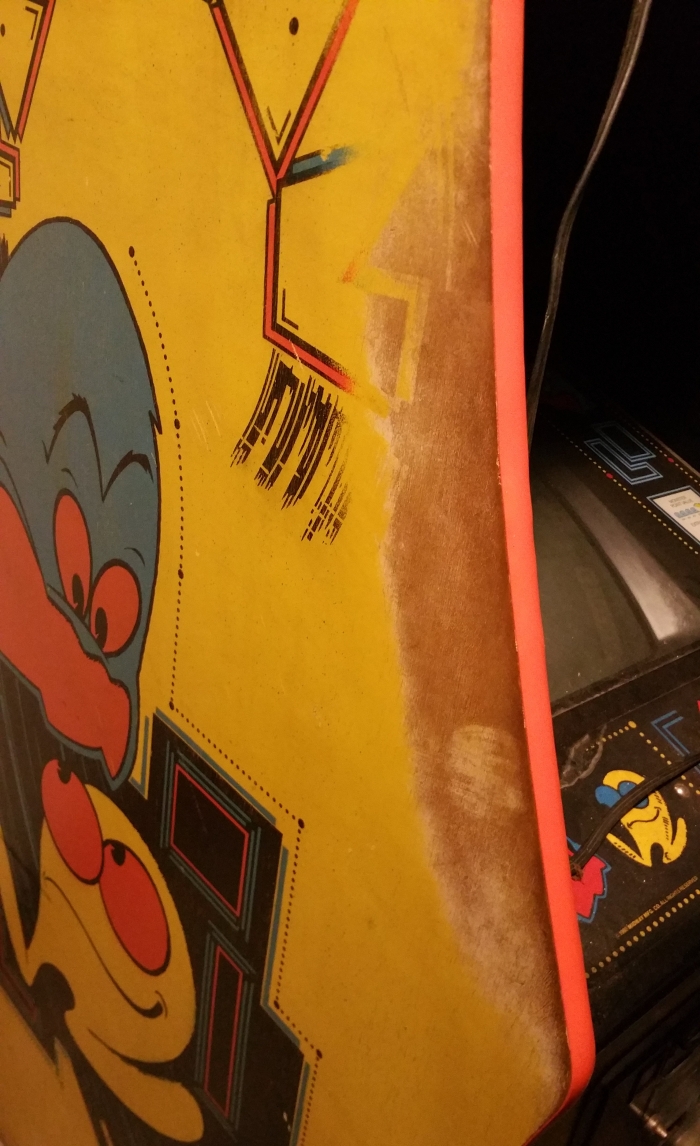
Human beings leave physical impressions upon the things they love and use just as much as their do upon the lives of people and the planet they live upon. For every action, there’s a reaction. For every pressure, there’s an affect on mass and volume. And in the impressions left by that combination, particularly if you’re lucky enough to see the sides of a rare, unrestored vintage Pac-Man cabinet, lies the never before told story of how we really played the game.
Until now, I don’t believe anyone has ever written about it.
In The Beginning: One Big Yellow Box of Dopamine

The short, fat, bright yellow box with “Scrubbing Bubbles” on the side didn’t receive a lot of attention when it first appeared in neighborhood arcades dominated by tall, black intricately designed cabinets in the Fall of 1980. I know a lot of game journos have written otherwise, claiming it was an over-night sensation, but they’re mistaken.
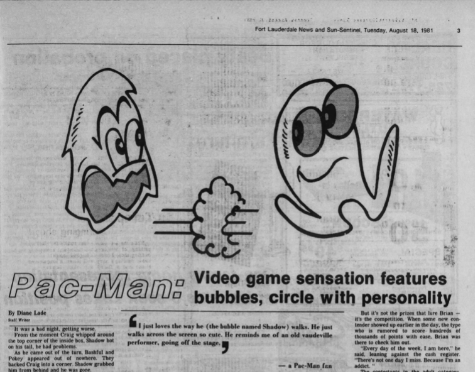
Released in America in October 1980 yet arriving in arcades closer to late November, Pac-Man rolled in like a guest at the wrong address. Since America was right in the middle of “the shooter craze”, when the competitive gaming scene was focused exclusively on mastering difficult multi-buttoned games, Pac-Man’s debut quite literally looked like a birthday party arriving on the front lines of World War III. Aesthetically, it didn’t fit in. Although some people migrated to it quickly, the press paid it little attention until full “Pac-Mania” finally hit in the Summer of 1981, its shift from a fad to a full-blown craze delayed by a historically brutal sub-arctic winter in many parts of America which kept millions of grade school gamers out of the arcades until things warmed up. Plus, like I mentioned before, the competitive craze was focused on “space shooters” so the press spotlighted that.
However, when the press suddenly decided to finally pay attention to Pac-Man, they chose to use the Pac-Man craze, or “Pac-Mania” as it was commonly referred to, as a platform to paint video games as an “unhealthy obsession” and to complain and vilify gamers. It was on the back of Pac-Man that many unjust city ordinances were passed against the operation of video game arcades.
But no matter how many laws and ordinances were passed, nothing could stop America’s love for Pac-Man. As I mentioned in the beginning of this article, the three main things humankind gravitates towards their entire lives are the beloved, a necessity or a fascination. Pac-Man ignited all three things at once, and for awhile, it burned brighter than any religion.
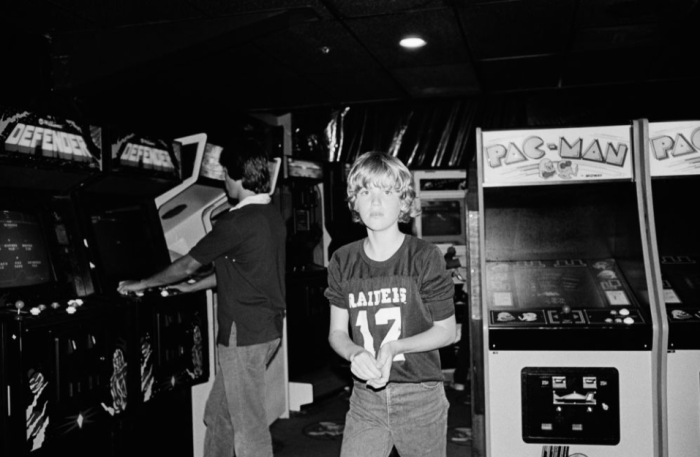
In bars, pizza places and coastal resort towns in late 1980, places where leisure arcade play took precedent over competitive players who wildly pushed their bodies and minds, Pac-Man made instant, life long friends. There, in a calmer, more relaxed atmosphere, in places where high school kids, tourists and all the other members of a non-competitive public gathered to relax and play a casual game, Pac-Man spun its bright yellow magic, bewitching players like no game had since Space Invaders in the late 70s. For a moment in 1981, we totally forgot there was a Cold War with Russia going on. For a moment, the world wasn’t contracting with the pains of a global economic recession giving birth to international crime syndicates. We even managed to forget the absolute insanity that a former Hollywood d-list actor was President of The United States. That summer we felt sweetly insulated from reality as we escaped into Raiders of The Lost Ark, The Scorpions, MTV and Pac-Man, that big, yellow box of dopamine that kept the nation high during many worldwide historical lows.
Just like Def Leppard sang on the opening track of their hit 1981 Summer album, “High and Dry“, “Let it rock…Let it roll…yeah, just let it go“, people did exactly that. They let it go, they let the weird, awful things about 1981 just slide and threw themselves into video games, materialism and the exploding pop culture escapism the era had delivered like a blindfold from a merciful god. (Sound familiar 2019?)

But happiness is always short-lived. In spite of all the joy Pac-Man brought, the press was negative. Many people were horrified by millions of people plunking quarters into it, oblivious that people had been obsessively putting coins into video games for awhile. It wasn’t a new thing. The video craze had been going on since 1978. Marathon players of Asteroids and Defender, competitors who played so hard they sometimes puked and passed out at the controls, had been making headlines in their home town newspapers since 1980. But what was new was that everyone –and I mean everyone– was interested in arcade video games now. Old, young, man, woman, child. And it was that which made the press finally give Pac-Man press albeit unfavorable.
In 1981, the press needed a poster child for video game obsession, something dark and scary to rile up their faithful readers with. Pac-Man was the perfect scapegoat to saddle as fear and ride into American homes via nightly newscasts and the Sunday paper. It wasn’t a drug per say. But it acted like one.
It spite of all that, Pac-Man still became one of the most successful arcade games of all time and an enduring iconic symbol of The 80s.
So…How Do You Play Pac-Man?

If you’ve come here looking for patterns on how to make it to level 255 with a maximum score or pursue obtaining a “perfect game”, sorry to disappoint you. There are many sites you can Google that will show you how to do that. (Or you could just go to an arcade without witnesses, get your buddy with an internationally recognized scoreboard to report that you played a “perfect game” and spend your life claiming you’re the “Gamer of The Century” like one guy did)
But, seriously, I’m talking about how a person stands when they play Pac-Man on an original arcade game. Not how someone beats the game and reaches the split-screen.
If it’s been a while since you played Pac-Man on an original arcade game cabinet, let me refresh your memory: Put in your quarter, hit the one-player button and grab the joystick. All you have to do is move Pac-Man through a series of tight cornered mazes, trying to eat all the dots and fruit on screen while also trying to out-maneuver a group of ghosts who will kill you as soon as they touch you. If you eat one of the energizer dots, though, you’ll have a short period of gameplay where the ghosts slow down and stop chasing you so you can eat the ghosts and pick up extra points. But something else happens, something I’ve never seen anyone ever mention in any article or video before. It’s a physical response and it always occurs by the time the player reaches the second screen…
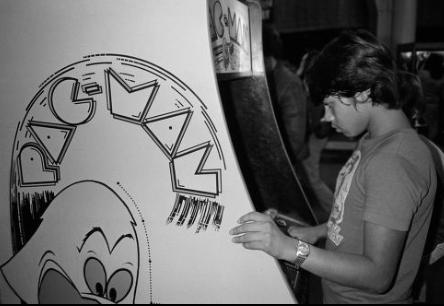
Pac-Man is more of a driving game than a maze game. As you’re playing, you’re jamming that joystick left and right, up and down, movements that shifts your right shoulder forward and back, rocking your body side to side. When the going gets tough, and the ghosts start closing in, all of this rocking motion compels you to lean into the game and, whether you realize you’re doing it or not, you’re going to grab onto the game. You actually need to get a grip…on something. You’re either going to lean hard against your left palm as it rests on the control panel which isn’t comfortable for very long or, like most people, you’re going to grab the side of the game and hold on tight. You have to or you’ll lose your balance. You can’t take the sharp corners smoothly and quickly without doing this, ether. You need the extra stabilization to move Pac-Man around the corners accurately.
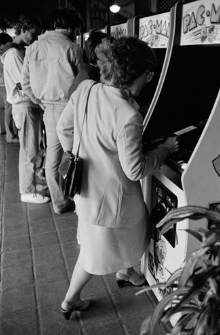
Whether intentional in its design or not, Pac-Man was a game that forced the player to hold onto it whether he/she was standing or sitting because the game had a “balance problem”. I don’t mean that the game rocked back and forth on unstable feet, which could be a problem for any arcade cabinet if the floor was uneven. I mean that the game made the player feel less in control of their own balance because its only controls were a joystick. No button to fire. No shields to launch or power-up buttons of any kind. If the joystick had been a steering wheel, a dial like on Tempest or a trakball like on Missile Command or Centipede, the balance problem wouldn’t have existed as much. Thousands of Pac-Man’s wouldn’t have left-hand sides worn down to the wood.

Most space-shooters released at the same time had multiple buttons and/or a joystick set to the side. This prompted most players to stand with their feet planted out from the game, legs spread and both hands on the control panel, weight distributed back onto the balls of the feet and upper body weight positioned forward onto the hands. Often called “the power stance”, this posture was most effective when playing Defender or trak-balled games like Missile Command or Centipede.
But since Pac-Man only had a joystick it forced the player to stand rather close to it so that their stomachs were almost touching it. With nothing to hold onto to or lean into to compensate for the unstable-feeling in your center axis, driving Pac-Man through mazes with hair-pin curves, the player had to grab the side of the game for balance. It was a necessity.
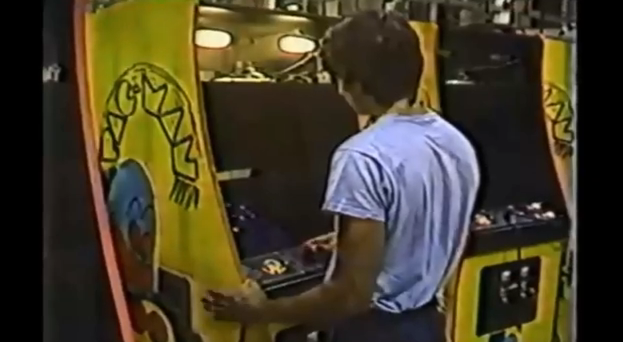
Original unrestored Pac-Man cabinets almost always show this kind of wear-pattern caused by the thousands, oftentimes millions, of left-hands that once gripped it during gameplay. Even when the game was brand new and not even off the assembly line, its own factory workers grabbed its side while playing it.
Since right-handed people account for over 70% of the population, Pac-Man shows wear mostly on the left side. However, right-hand side wear from left handed people is evident as well, but since left-handed people are less common the wear pattern is less.
If the Pac-Man game was set up in a line up of games stacked tight together you’ll still see a wear-pattern on the left side but it’s less marked. This is because players gripped the edge of the side molding with only the tips of their fingers and not the whole hand. In fact, you can often tell by looking at the wear pattern on a Pac-Man how it was positioned in the arcade.


I can’t think of many games that show that kind of wear pattern, other than Q*bert and, of course, Ms. Pac-Man for obvious reasons. However due to Q*bert having a sturdier lacquered side with a sticker rather than a painted side like Pac-Man does, the wear is almost always less decipherable since laminate is more durable and resistant to the sweat and oils on human hands.
The Pac-Stance: Photos of Players Holding On: See for Yourself


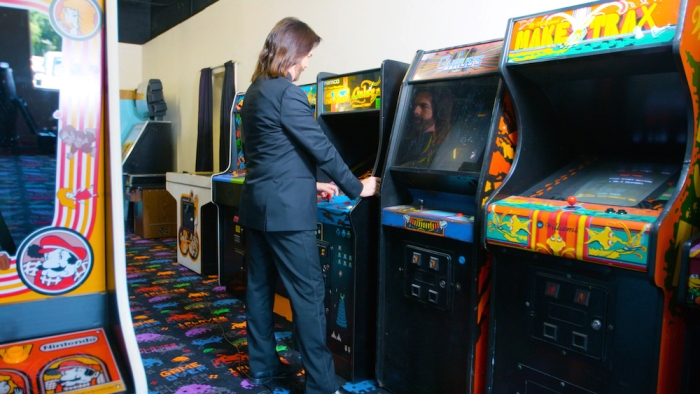



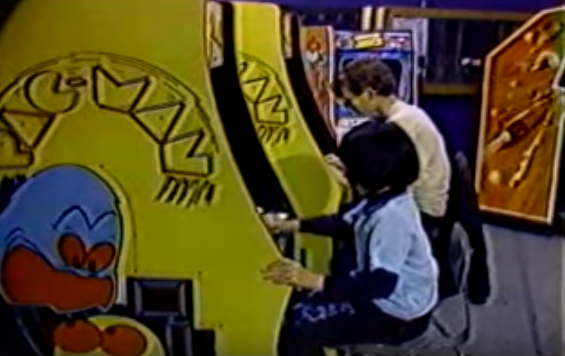
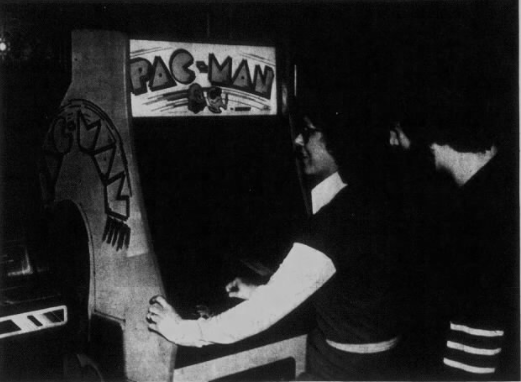
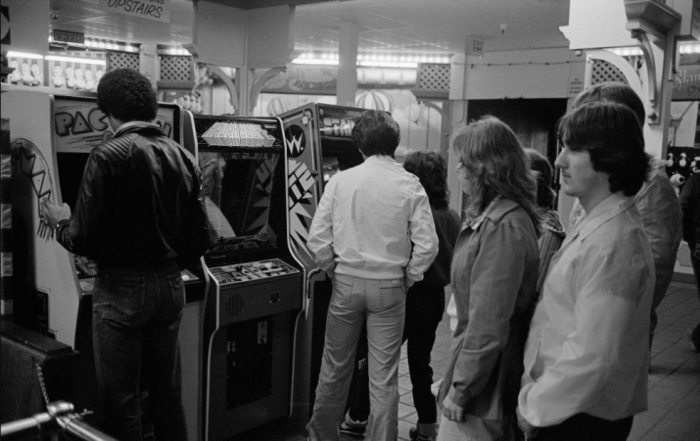
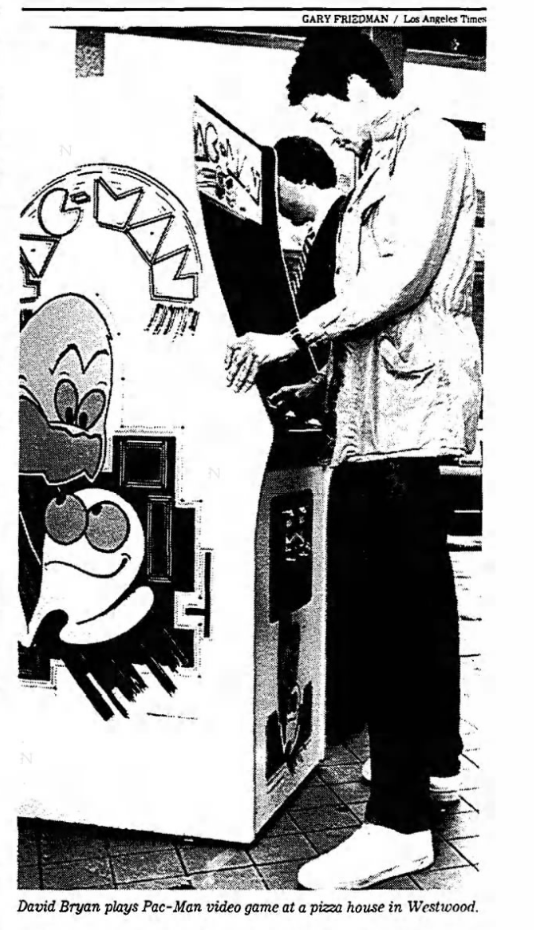


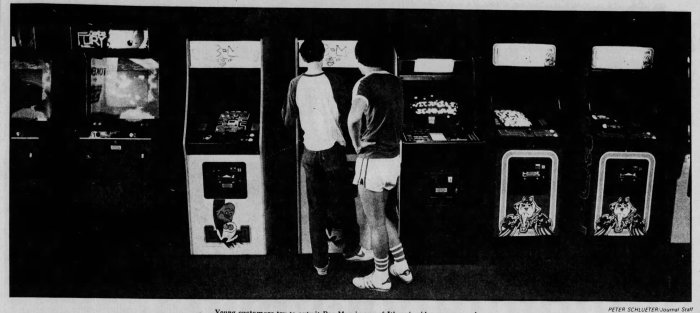
Pac-Man’s Scars: Signs of An American Cultural Rebellion
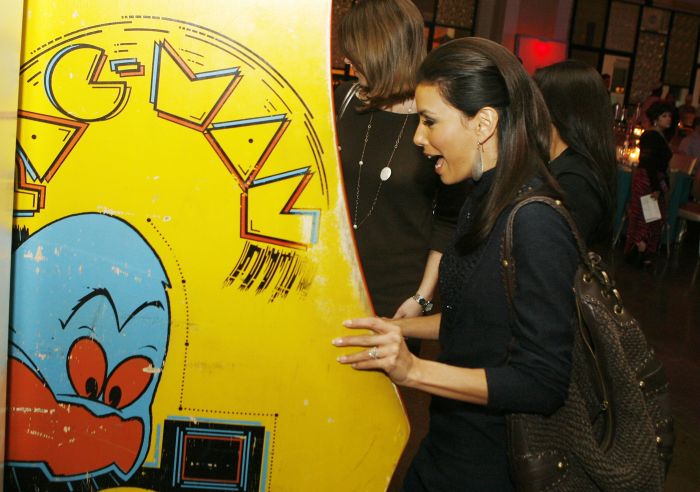
If you look online, the most common image of a Pac-Man cabinet is one that has been repainted, oftentimes the wrong color yellow and shiny, with a cheezy sticker for side art. The sight of them makes me sick. They never looked like that.
Pac-Man was originally stenciled, had matte yellow paint on the entire cab, then the characters were sprayed on which is why the original cadmium yellow paint covering the cabinet was splattered with flecks of blue over-spray drops. Rarely, and only rarely, will you ever see a Pac-Man in its original state, and when you do people apologize for it.
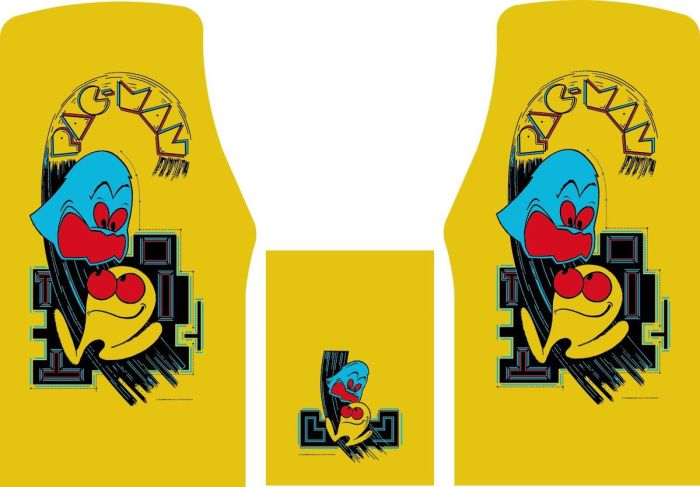
Because it’s been a fad for years to make your old arcade games look brand new, people are ashamed of games that retain their original finish and patina. The apology should be the other way around. The “restorer” should be ashamed of what he or she has done, and the guys who make money off pushing full restoration materials should be ashamed of contributing to the destruction of vintage arcade games instead of properly educating “restorers” on the pros and cons of doing so. The only reason why people “restore” vintage arcade games is usually to command higher prices on a market that typically sells to novice collectors. The practice has little to do with preservation and much more to do with profiting off the naive.
Pac-Man’s worn left-side is part of the game’s provenance. It’s unique only to Pac-Man games, including Ms. Pac-Man. It’s evidence left by “Pac-Mania” and also evidence of how the game was really played. It’s a time signature left by a generation of the first gamers. It’s history that should be preserved intact. It tells a story that we’ll never see written again.
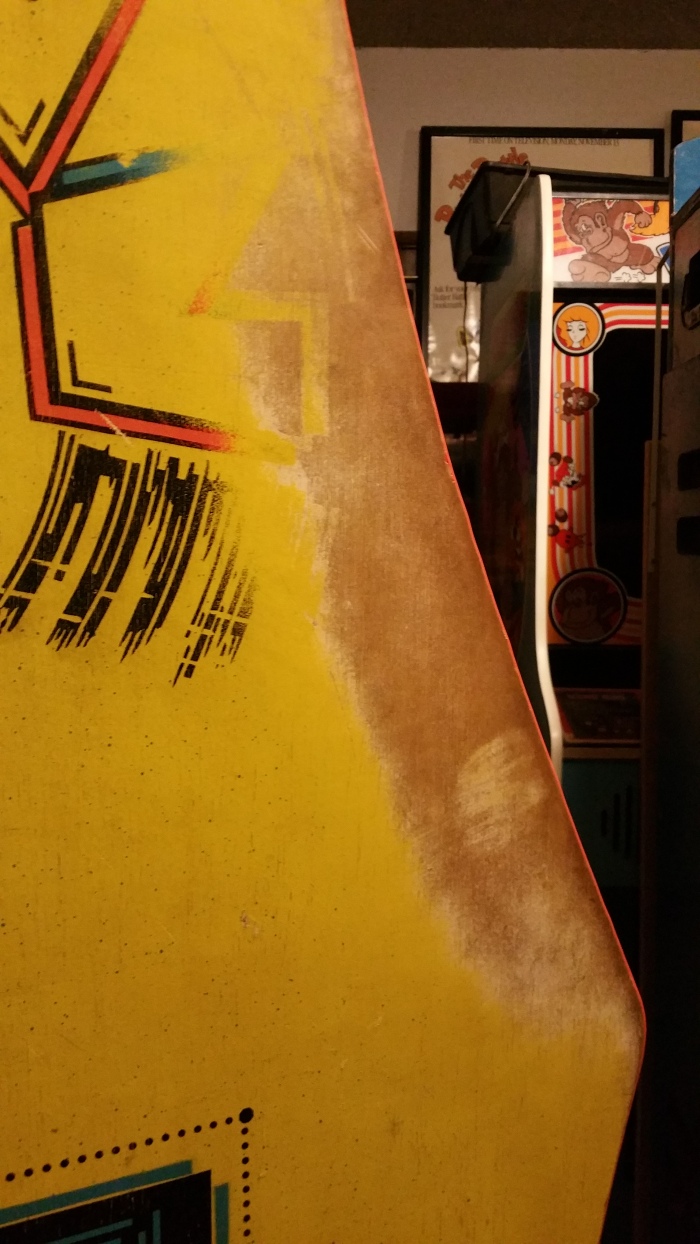 Why anyone would want to destroy something that reflects a cultural phenomenon in gaming boggles my mind. It’s confusing even more to me that people can’t see it, can’t see the worn side of the game and know exactly what put it there and find it beautiful –hands. Thousands of human hands. Millions, even. Hands of many colors, many sizes; white collar hands, blue collar hands, no-collar hands. Hands that put a quarter in a machine that was attacked by the press as being “addicting” and “unhealthy”. Ordinances were passed that helped kill the video craze off early because of Pac-man, because a generation of newly risen gamers couldn’t keep their hands off it and, in a free country, shouldn’t have been expected to anyway. That scar was put there by an act of defiance.
Why anyone would want to destroy something that reflects a cultural phenomenon in gaming boggles my mind. It’s confusing even more to me that people can’t see it, can’t see the worn side of the game and know exactly what put it there and find it beautiful –hands. Thousands of human hands. Millions, even. Hands of many colors, many sizes; white collar hands, blue collar hands, no-collar hands. Hands that put a quarter in a machine that was attacked by the press as being “addicting” and “unhealthy”. Ordinances were passed that helped kill the video craze off early because of Pac-man, because a generation of newly risen gamers couldn’t keep their hands off it and, in a free country, shouldn’t have been expected to anyway. That scar was put there by an act of defiance.
Your own hands may have gripped the sides of a Pac-Man machine in The 80s. I know mine did. Every time I see that scar on the side of a Pac-Man I see a legacy left by the first gamers whose actions told the government, “Fuck you. I’m going to play.”
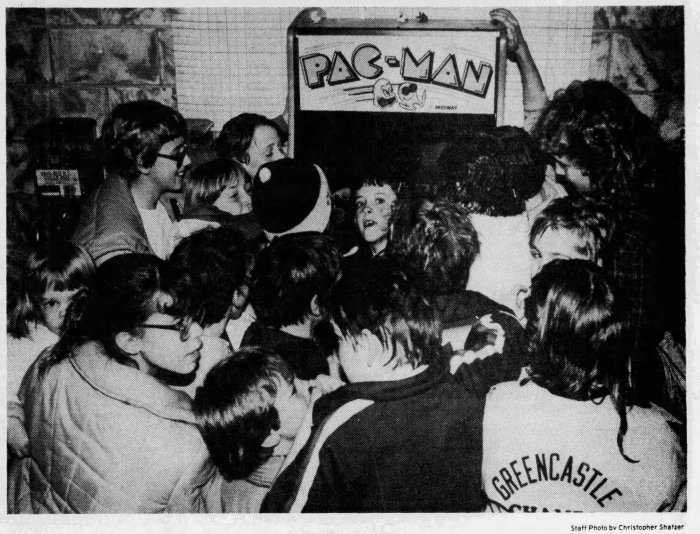
When I look at my own Pac-Man and see that scar on its left side, pride wells up in me. See, I don’t just know why it’s there, but I know what the world looked, smelled and sounded like when the process that would one day create that scar began. 1981 and the clamber of that amazing year floods back to me. It’s like if you’ve ever gone back into an arena after a massive concert, where paper cups, confetti and flyers litter the ground, and you can still feel the after-thrill of the music in the leftover chaos and in the air around you; how it feels good to know you were there, had been part of a momentary rush of earthly cosmos whose effect on your soul escapes description because the ethereal can never be pinned down with words. I can feel all that in that scar by remembering how it got there and what that meant.
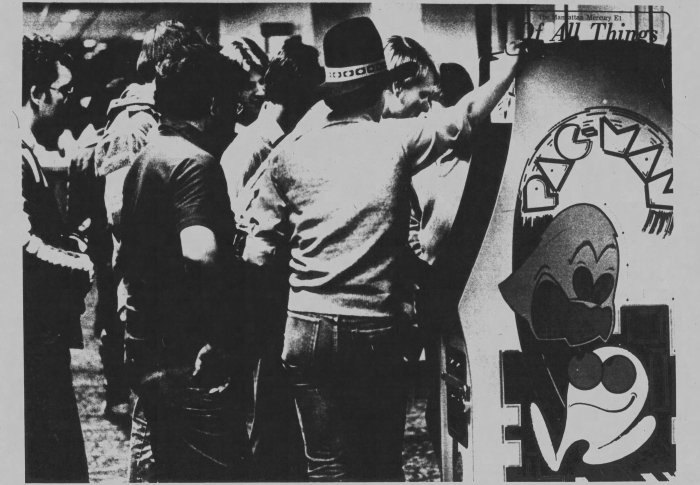
That’s what I feel when I see the worn sides of a Pac-Man and run my fingers over the part where the paint is worn down to wood. I remember the crowds of people surrounding that big yellow box, in lines 10-deep, people jostling to watch the gameplay, the scent of Herbal Essence shampoo, Brut and Irish Spring thick in the air. And the hands, all those hands grabbing at the sides of the game, one player right after the other, quarters jingling in the palms of those waiting their turns, eyes focused on the screen, expectation and enchantment reverberating through the crowd just as it does before the ball drops on New Year’s Eve in Times Square. Everyone whose turn came up felt like a celebration. Everyone who lost, and we all did, still felt like a winner.
That scar on the side of Pac-Man allows me to make an instant connection to its provenance, its past. When I touch it, I’m touching the ghosts of a million hands from a generation I belong to.
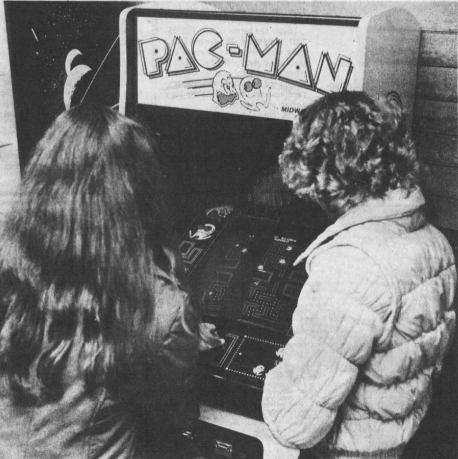

Until next time, may all your quarters be red ones.
BONUS:
I
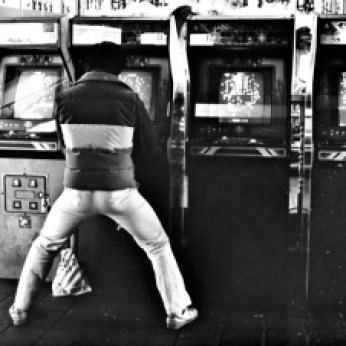

Possible translate this beautiful article for Italian people? I can do it and write your credit
LikeLiked by 1 person
Yes, please. I would be honored by such a thing as that.
LikeLike
Thank you very much. Now start to translate and than write here link.
LikeLiked by 1 person
Grazie molto 🙂
LikeLike
Fish to translate. Now, with your permission, I post it on my blog with the necessary credits
LikeLike
The Italians thank you for this beautiful article and I thank you too. Dear
LikeLike
Great article, loved reading this. Brought back a lot of memories.
LikeLike
You’re a delight to read. I love the humanity you convey for what many consider to be a meaningless pastime. Keep up the wonderful work and I would buy a book written by you that was on the topic of 80s culture.
LikeLiked by 1 person
Thank you for the kind words and appreciation. It means everything to me 🙂
LikeLike
What an incredibly touching, lovely piece. I’ve never read before any piece of video game writing that really captures the soul of what arcade gaming means to me. Great job!
LikeLiked by 1 person
Thank so very much.
LikeLike
Thank you very much for this history. Keep on doing so. Those of us outside of the USA, had no idea, or some idea by now, how the pacman/mspacman craze was like a cornona virus in the 1980 in the USA. Here outside of the USA arcades were more moderate and still long running (in business) after golden arcade era was dead in the USA due to console gaming.
LikeLiked by 1 person
Very moving and original take on the subject! Thanks!
LikeLiked by 1 person
This is a topic which is near to my heart… Thank you! Where are your contact details though?
LikeLike
I should probably get those up, huh? 🙂
LikeLike